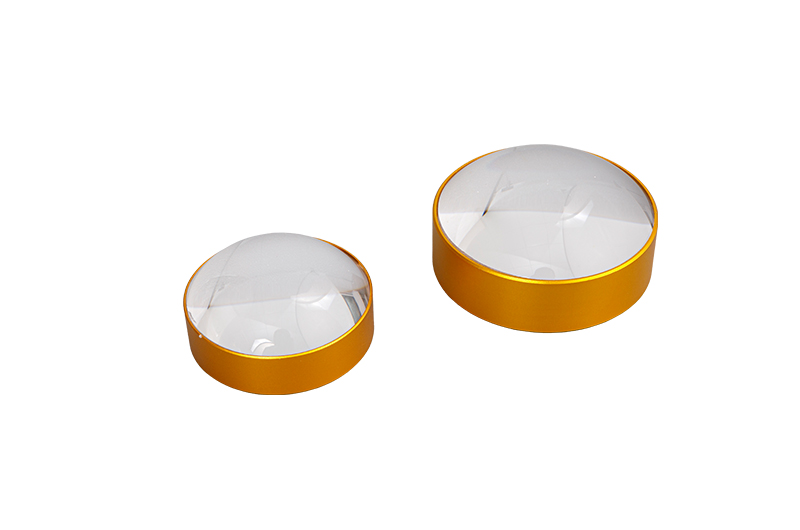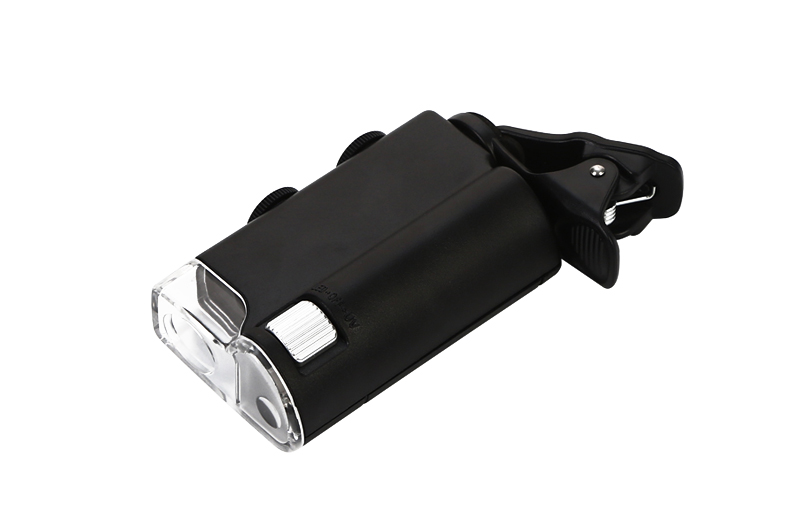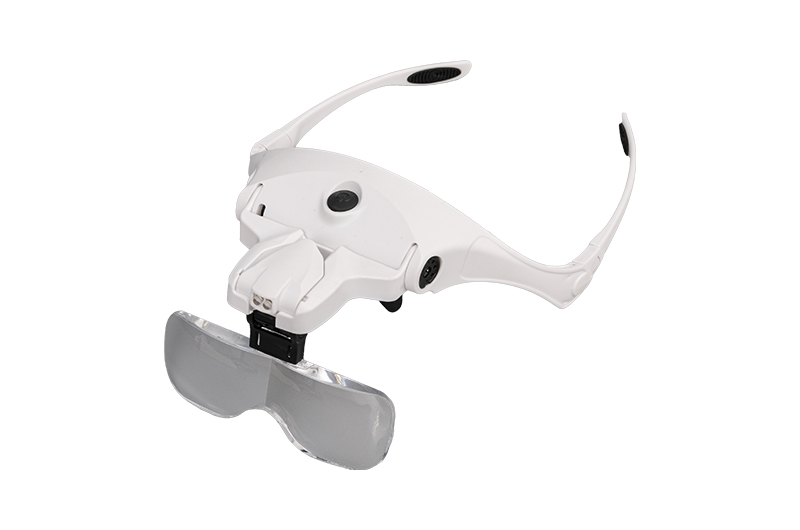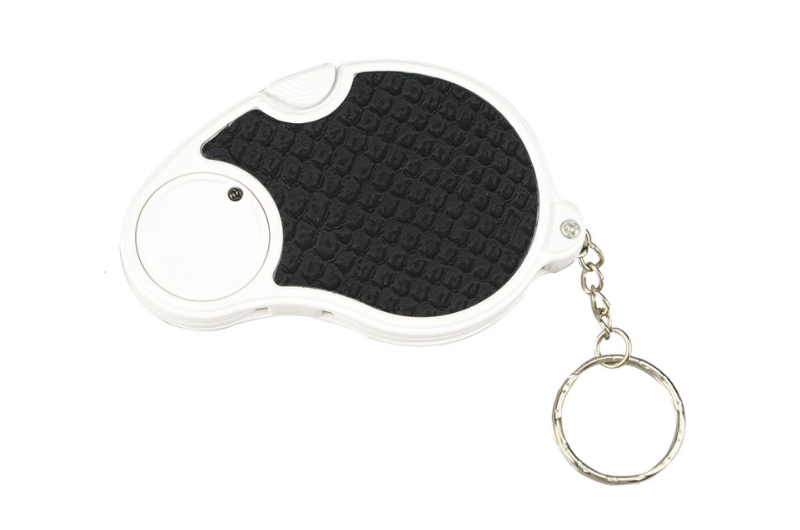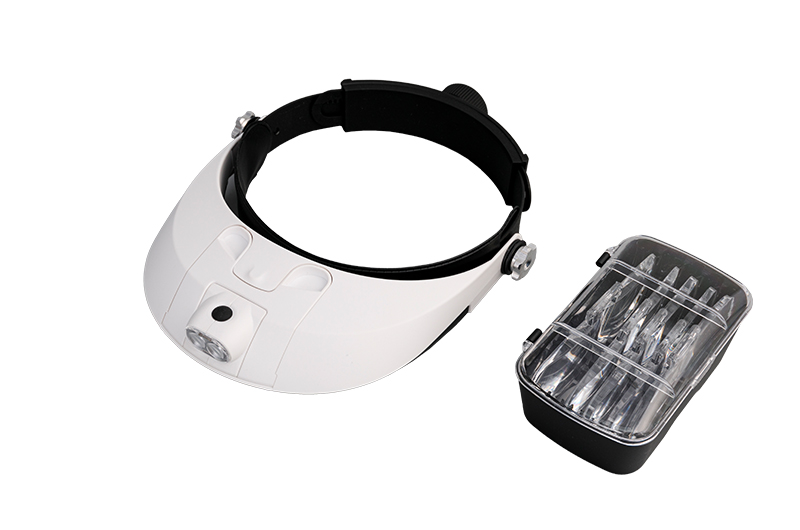Telescope Supplier – Astronomical telescope children’s science and education experiment entry-level telescope – OPTICAL INSTRUMENT
Telescope Supplier – Astronomical telescope children’s science and education experiment entry-level telescope – OPTICAL INSTRUMENT Detail:
Product Parameters
| Model | KY-F36050 |
| Power | 18X/60X |
| Luminous aperture | 50mm (2.4 ″) |
| Focal length | 360mm |
| Oblique mirror | 90° |
| Eyepiece | H20mm/H6mm. |
| Refractive / focal length | 360mm |
| Weight | About 1kg |
| Material | Aluminium Alloy |
| Pcs/ carton | 12pcs |
| Color box size | 44CM*21CM*10CM |
| Weight/carton | 11.2kg |
| Carton size | 64x45x42cm |
| Short Description | Outdoor Refractor Telescope AR Telescope for Kids Beginners |
Configuration:
Eyepiece: h20mm, h6mm two eyepieces
1.5x positive mirror
90 degree zenith mirror
38 cm high aluminum tripod
Manual warranty card certificate
Main indicators:
★ refractive / focal length: 360mm, luminous aperture: 50mm
★ 60 times and 18 times can be combined, and 90 times and 27 times can be combined with 1.5x positive mirror
★ theoretical resolution: 2.000 arcseconds, which is equivalent to two objects with a distance of 0.970 cm at 1000 meters.
★ main lens barrel color: silver (as shown in the picture)
★ weight: About 1kg
★ outer box size: 44cm * 21cm * 10cm
Viewing combination: 1.5x positive mirror h20mm eyepiece (full positive image)
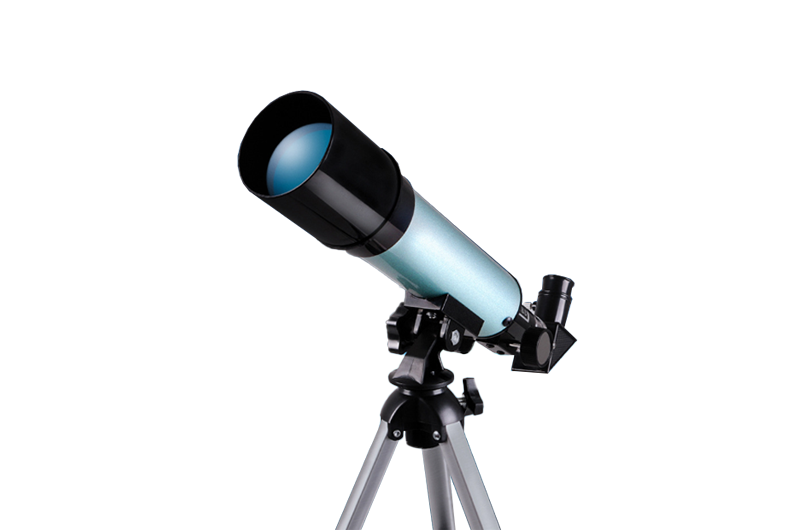
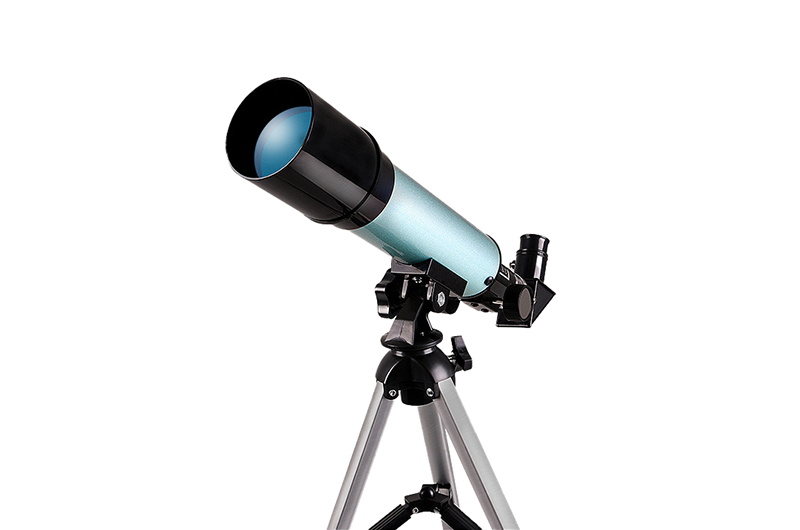
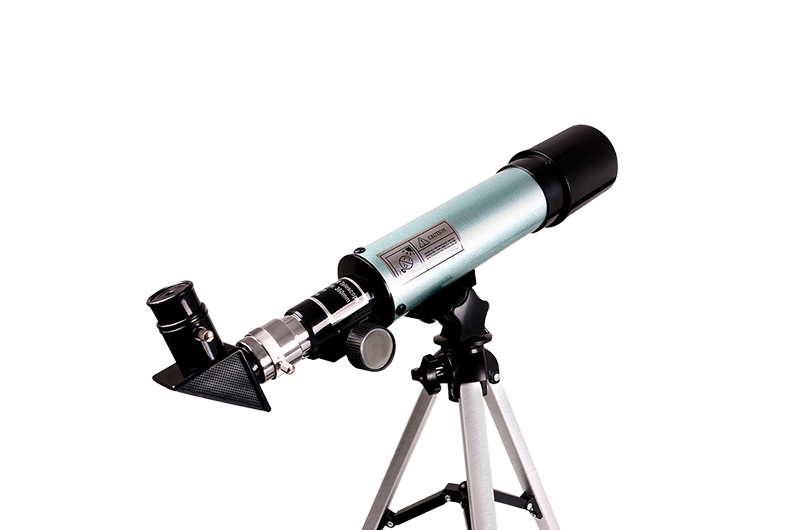

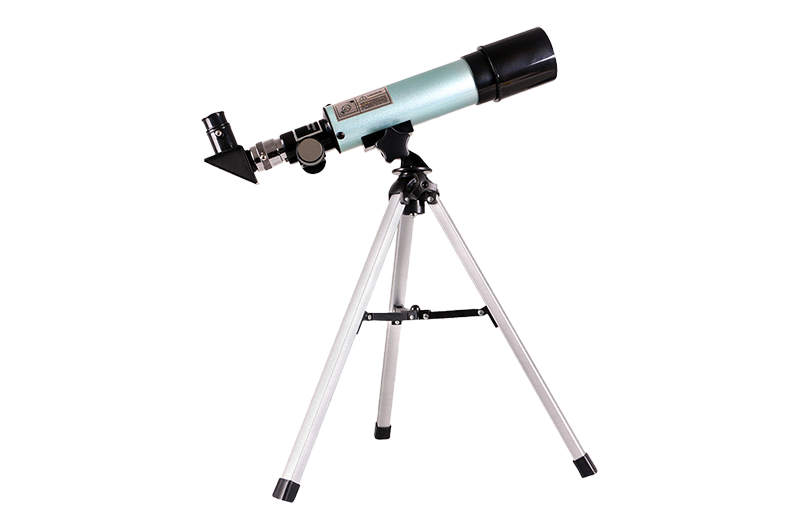
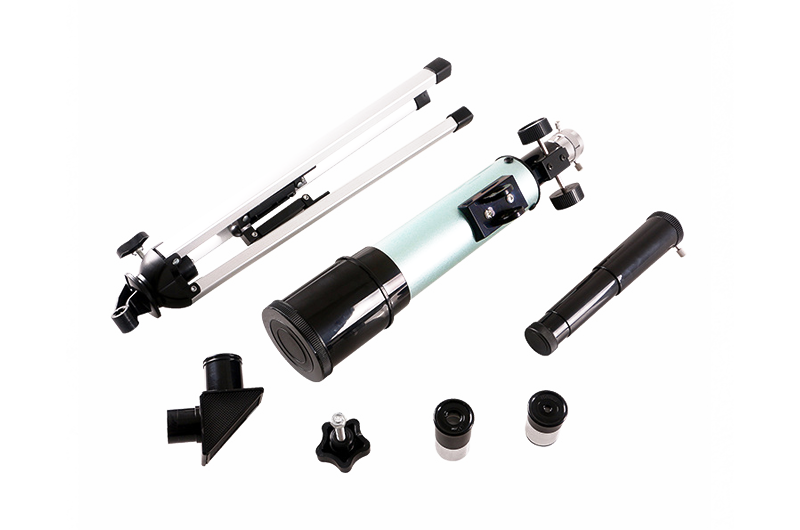
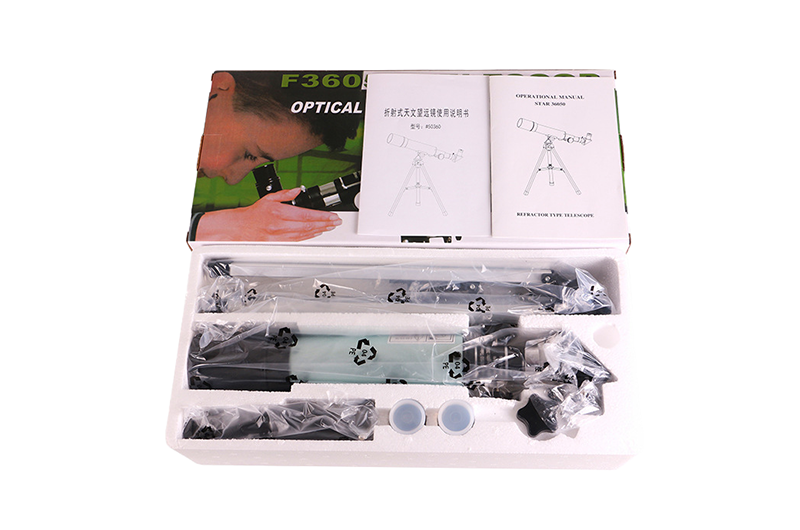
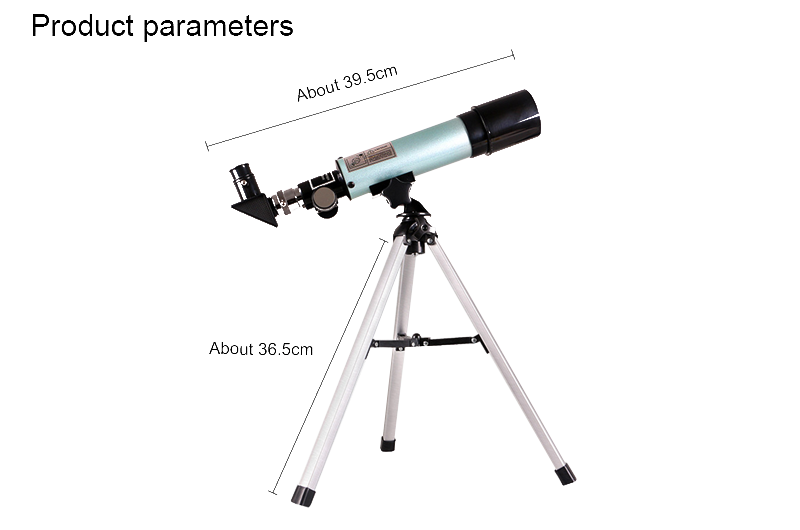
Usage rules:
1. Pull apart the supporting feet, install the telescope barrel on the yoke and adjust it with large locking screws.
2. Insert the zenith mirror into the focusing cylinder and fix it with corresponding screws.
3. Install the eyepiece on the zenith mirror and fix it with corresponding screws.
4. If you want to magnify with a positive mirror, install it between the eyepiece and the lens barrel (there is no need to install a 90 degree zenith mirror), so that you can see the celestial body.
What is Astronomical telescope?
Astronomical telescope is the main tool for observing celestial bodies and capturing celestial information. Since Galileo made the first telescope in 1609, the telescope has been developing continuously. From optical band to full band, from ground to space, the observation ability of the telescope is becoming stronger and stronger, and more and more celestial body information can be captured. Human beings have telescopes in electromagnetic wave band, neutrinos, gravitational waves, cosmic rays and so on.
Development History:
Telescope originated from glasses. Humans began to use glasses about 700 years ago. Around 1300 ad, Italians began to make reading glasses with convex lenses. Around 1450 ad, myopia glasses also appeared. In 1608, an apprentice of H. Lippershey, a Dutch eyewear manufacturer, accidentally discovered that by stacking two lenses together, he could clearly see things in the distance. In 1609, when Galileo, an Italian scientist, heard of the invention, he immediately made his own telescope and used it to observe the stars. Since then, the first astronomical telescope was born. Galileo observed the phenomena of sunspots, lunar craters, the satellites of Jupiter (Galileo satellites) and the profit and loss of Venus with his telescope, which strongly supported Copernicus’s heliocentric theory. Galileo’s telescope is made of the principle of refraction of light, so it is called a refractor.
In 1663, Scottish astronomer Gregory made a Gregory mirror by using the reflection principle of light, but it was not popular because of the immature manufacturing technology. In 1667, the British scientist Newton slightly improved Gregory’s idea and made a Newtonian mirror. Its aperture is only 2.5cm, but the magnification is more than 30 times. It also eliminates the color difference of the refraction telescope, which makes it very practical. In 1672, the Frenchman Cassegrain designed the most commonly used Cassegrain reflector by using concave and convex mirrors. The telescope has long focal length, short lens body, large magnification and clear image; It can be used to photograph large and small celestial bodies in the field. The Hubble telescope uses this kind of reflection telescope.
In 1781, British astronomers W. Herschel and C. Herschel discovered Uranus with a self-made 15 cm aperture mirror. Since then, astronomers have added many functions to the telescope to make it have the ability of spectral analysis and so on. In 1862, American astronomers Clark and his son (A. Clark and A. g. Clark) made a 47 cm aperture refractor and took pictures of Sirius companion stars. In 1908, American astronomer Haier led the construction of a 1.53 meter aperture mirror to capture the spectrum of Sirius companion stars. In 1948, the Haier telescope was completed. Its aperture of 5.08 meters is enough to observe and analyze the distance and apparent velocity of distant celestial bodies.
In 1931, the German optician Schmidt made the Schmidt telescope, and in 1941, the Soviet astronomer mark sutov made the mark sutov Cassegrain reentry mirror, which enriched the types of telescopes.
In modern and contemporary times, astronomical telescopes are no longer limited to optical bands. In 1932, American Radio Engineers detected radio radiation from the center of the Milky Way galaxy, marking the birth of radio astronomy. After the launch of man-made satellites in 1957, space telescopes flourished. Since the new century, new telescopes such as neutrinos, dark matter and gravitational waves are in the ascendant. Now, many messages sent by celestial bodies have become the fundus of astronomers, and human vision is becoming wider and wider.
In early November 2021, after a long period of engineering development and integration testing, the much anticipated James Webb Space Telescope (JWST) finally arrived at the launch site located in French Guiana and will be launched in the near future.
Working principle of astronomical telescope:
The working principle of astronomical telescope is that the objective lens (convex lens) focuses the image, which is amplified by the eyepiece (convex lens). It is focused by the objective lens and then amplified by the eyepiece. The objective lens and eyepiece are double separated structures, so as to improve the imaging quality. Increase the light intensity per unit area, so that people can find darker objects and more details. What enters your eyes is almost parallel light, and what you see is an imaginary image magnified by the eyepiece. It is to enlarge the small opening angle of the distant object according to a certain magnification, so that it has a large opening angle in the image space, so that the object that cannot be seen or distinguished by the naked eye becomes clear and distinguishable. It is an optical system that keeps the incident parallel beam emitted in parallel through the objective lens and eyepiece. There are generally three types:
1、 Refraction telescope is a telescope with lens as objective lens. It can be divided into two types: Galileo telescope with concave lens as eyepiece; Kepler telescope with convex lens as eyepiece. Because the chromatic aberration and spherical aberration of single lens objective are very serious, modern refraction telescopes often use two or more lens groups.
2、 A reflecting telescope is a telescope with a concave mirror as the objective lens. It can be divided into Newton telescope, Cassegrain telescope and other types. The main advantage of the reflecting telescope is that there is no chromatic aberration. When the objective lens adopts a paraboloid, the spherical aberration can also be eliminated. However, in order to reduce the influence of other aberrations, the available field of view is small. The material for manufacturing the mirror only requires small expansion coefficient, low stress and easy grinding.
3、 Catadioptric telescope is based on spherical mirror and added with refractive element for aberration correction, which can avoid difficult large-scale aspherical processing and obtain good image quality. The famous one is the Schmidt telescope, which places a Schmidt correction plate at the spherical center of the spherical mirror. One surface is a plane and the other is a slightly deformed aspherical surface, which makes the central part of the beam converge slightly and the peripheral part diverge slightly, just correcting the spherical aberration and coma.
Product detail pictures:
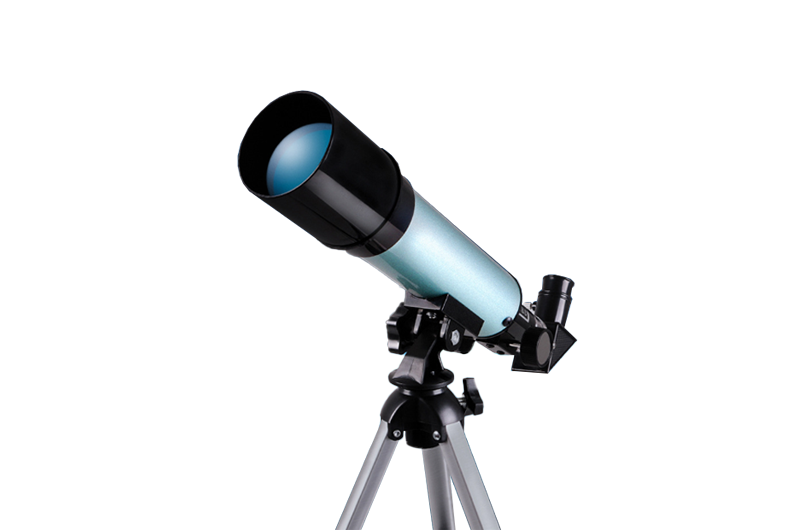
Related Product Guide:
We usually perform being a tangible workforce making sure that we will give you the most beneficial excellent plus the finest selling price for Telescope Supplier – Astronomical telescope children’s science and education experiment entry-level telescope – OPTICAL INSTRUMENT, The product will supply to all over the world, such as: Puerto Rico, Islamabad, Rio de Janeiro, Our company warmly invites domestic and overseas customers to come and negotiate business with us. Allow us to join hands to create a brilliant tomorrow! We've been looking forward to cooperating with you sincerely to achieve a win-win situation. We promise to try our best to deliver you with high quality and efficient services.
Speaking of this cooperation with the Chinese manufacturer, I just want to say"well dodne", we are very satisfied.






